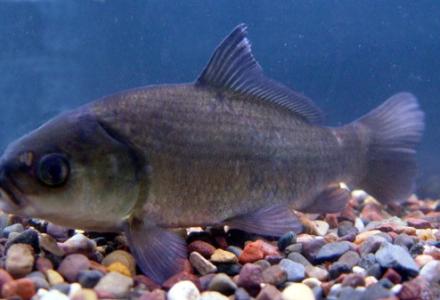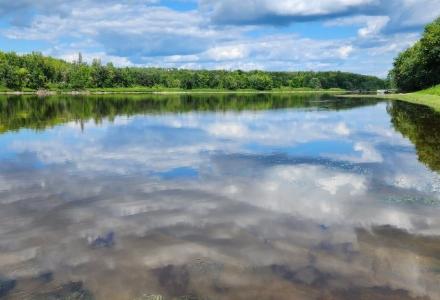
Managing sustainable fish populations in the Red River and into Lake Winnipeg requires cross-boundary cooperation and a whole lot of data about where fish are spawning, feeding and living. An ongoing binational project tagging fish to track their movements is beginning to show how invasive common carp and native species such as channel catfish, bigmouth buffalo, lake sturgeon and walleye are using their environment and where there are bottlenecks in the river network.
The project was started two years ago by Fisheries and Oceans Canada (DFO), and will run until 2022, according to Eva Enders, a research scientist with the agency. To track the fish, researchers caught them and surgically implanted small transmitter tags into each creature before releasing them back into the same waters. The tags emit an acoustic signal every one to three minutes. Using a network of receivers throughout the Red River, in parts of Lake Winnipeg and the Assiniboine and Winnipeg rivers, researchers can detect tagged fish every time they pass within 1-2 km of a receiver.
“The receivers log the unique code of the tags, and we know when and at which receiver the fish passed,” Enders said. Every six to 12 months, researchers go out and gather the data from the receivers.
(See also: “Alewives Rebounding in Latest St. Croix Fish Count”)
The Red River has had a traditional fish tagging program where catfish had tags clipped to them since 2012, said University of Nebraska fish ecologist Mark Pegg. When anglers pull up those tagged catfish, they can report seeing the tag, which gives researchers some idea of population and movements. Pegg said the new telemetry study using the transmitter tags allows for refined movement data, giving researchers the chance to see when and how far fish are moving.

Combined with information about environmental variables, Enders said water managers, who receive recommendations and reports by the International Red River Board, will be able to use the fish movement data to account for flows the studied fish species need to complete their life cycle.
While the data doesn’t directly point to where fish are spawning, Enders said researchers can see which waterways and areas fish return to during spawning season, indirectly pointing to spawning habitat locations. More directly, agencies in North Dakota, Minnesota and Manitoba can use that data to make better decisions on managing the fisheries.

Using the fish telemetry data, Enders said researchers can analyze which fish are able to make it past dams and locks on the Red River/Lake Winnipeg system. Those include the Drayton Dam and St. Andrews Lock and Dam on the Red River, and the Portage Diversion on the Assiniboine River.
Preliminary results suggest some downstream movement on the St. Andrews Lock and Dam, and limited upstream movement at St. Andrews and on the Portage Diversion.
Nevertheless, fish are moving to and from Lake Winnipeg into the Red River. Data is currently unavailable for the Drayton Dam as the information from the receivers is still being downloaded, according to Enders. Pegg noted that while St. Andrews Lock and Dam has a fish ladder, the other two dams are low-lying designs that only allow fish passage when the water is high enough.
When water conditions are right, fish have been detected moving across the Canada-US border in both directions, Pegg said. Still, this transboundary data could prove incredibly helpful in developing a united fisheries management strategy. Manitoba and the United States have different fishery management styles, Pegg said, but all agencies want to maintain the popular catfish sport fishing resource. With a better idea of how fish are using the water system, agencies can plan together around fish life cycles.
This data also could be helpful for restoration efforts of the endangered mapleleaf mussel, which uses the channel catfish as its only known host. By studying the host, Enders said, officials can try and set up a risk management plan for the catfish that can help repopulate the mussels.
The US Army Corps of Engineers also can use this fish movement study as baseline information as it constructs its Fargo-Moorhead flood diversion project, said Enders, to get an idea what the potential impacts might be on fish passage and life cycle if the project moves forward.
Funding for the study came through Fisheries and Oceans Canada, Manitoba Fish and Wildlife Enhancement Fund, Environment and Climate Change Canada, the Lake Winnipeg Foundation, Manitoba Hydro, Fish Futures Inc. and the IJC’s International Watersheds Initiative, which funded receivers on the US side of the Red River and for additional fish tagging and data management.


Kevin Bunch is a writer-communications specialist at the IJC’s US Section office in Washington, D.C.




